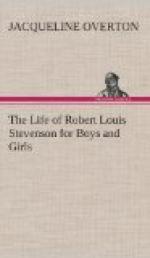Mrs. Stevenson, senior, returned with Lloyd from England, and later Mrs. Strong and her small son, Austin, came from Honolulu to make the family complete.
The servants were all natives, “boys” as they called themselves. There were usually about half a dozen about the house, with a boy for the garden and to look after the cows and pigs, besides a band of outside laborers, varying from half a dozen to thirty, under Lloyd’s direction.
Sosimo was Stevenson’s particular boy. He waited upon him hand and foot, looked after his clothes and his pony “Jack,” and was devoted in every way. His loyalty to his master lasted to the end of his own life.
The servants were governed on something very like the clan system. A Vailima tartan was adopted for special occasions and Stevenson encouraged them to think of the household as a family, to take interest and pride in all its doings.
On Sunday evenings the entire household was assembled. A chapter of the Samoan Bible was read and Samoan hymns sung. Then a prayer in English written by Stevenson was read, concluding with the Lord’s Prayer in Samoan.
If the master had cause to be displeased with any one of them, they were all summoned and reprimanded or fined.
His stories delighted them. They were never tired of looking at the picture of Skerryvore Light and hearing about the rugged coasts of Tusitala’s native island and of his father and grandfather who built lighthouses. The latter impressed them greatly, since building of any kind in Samoa is considered a fine art. The deeds of General Gordon, the Indian Mutiny, and Lucknow were likewise favorite tales when Tusitala showed them a treasure he prized highly: a message written by General Gordon from Khartoum. It was in Arabic on a small piece of cigarette-paper which might be easily swallowed should the messenger be captured. Stevenson always believed it to be the last message sent before the great general’s death.
They came to him for everything and he was ever ready with help and advice. They were quick to appreciate his justice and kindliness, and to a man were devoted to him. “Once Tusitala’s friend, always Tusitala’s friend,” they said.
With his customary energy he threw himself heart and soul for a time into the political troubles of the island, making himself the champion of the natives’ cause. He wrote a series of letters to the papers at home stating his idea of the injustice shown the Samoans under their present government. It was a most delicate situation, and at times led to very strained relations between himself and the officials in Apia.
Those at home wondered why Stevenson tampered with island politics at all. Why did he not simply leave them to the powers in charge?
His answer was, he had made Samoa his home, the Samoans were his people, and he could not fail to resent any injustice shown them.




